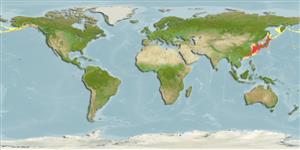Common names from other countries
Classification / Names / Names
आम नाम | उपशब्द | Catalog of Fishes (gen., sp.) | ITIS | CoL | WoRMS
Environment: milieu / climate zone / depth range / distribution range
पारिस्थितिकी
पिलाजिक; औशिनोड़िरोमस (Ref. 75927); गहराई सीमा 0 - 500 m (Ref. 275), usually 0 - 100 m (Ref. 275). Temperate; 5°C - 27°C (Ref. 275), preferred 9°C (Ref. 107945); 63°N - 18°N, 110°E - 135°W (Ref. 275)
Northern and Western Pacific and Northeast Atlantic.
Length at first maturity / आकार / वज़न / Age
Maturity: Lm ? range ? - ? cm Max length : 50 cm ML (female); common length : 30.0 cm ML पुल्लिंग / अलिंग; (Ref. 97142); अधिकतम प्रकाशित वज़न: 500.00 g (Ref. 275)
Common weight: 100 to 300 g (Ref. 275). Depth range is 36 to 184 m; and temperature is 12 to 20°C in Ref. 75927. Fished with jigging machines, demersal trawls, purse seines and set nets (Ref. 81298).
Life cycle and mating behavior
परिपक्व अवधि | पुनरुत्पत्ति | मछलीऔ का अंडे देना | अंडे | Fecundity | लार्वा
Members of the class Cephalopoda are gonochoric. Male and female adults usually die shortly after spawning and brooding, respectively. Mating behavior: Males perform various displays to attract potential females for copulation. During copulation, male grasp the female and inserts the hectocotylus into the female's mantle cavity where fertilization usually occurs. Life cycle: Embryos hatch into planktonic stage and live for some time before they grow larger and take up a benthic existence as adults.
Roper, C.F.E., M.J. Sweeney and C.E. Nauen. 1984. (Ref. 275)
IUCN Red List Status (Ref. 130435: Version 2024-1)
CITES status (Ref. 108899)
Not Evaluated
Not Evaluated
Human uses
मात्स्यिकी: व्यापारिक
FAO - मात्स्यिकी: landings, species profile | FishSource | Sea Around Us
साधन
इंटरनेट स्रोत
Estimates based on models
Preferred temperature
(Ref.
115969): 7.7 - 23.4, mean 18.3 (based on 366 cells).
लौटाव
ऊंचा, न्यूनतम जनसंख्या दुगनी समय अवलागत 15 महीने। (K=2.85-3.34).
Prior r = 1.18, 95% CL = 0.78 - 1.77, Based on 2 full stock assessments.
Vulnerability
Low vulnerability (25 of 100).
